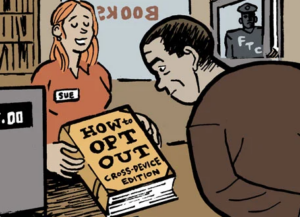The phrase “just because we can doesn’t mean we should” applies at the Consumer Electronics Show (CES) in Las Vegas, where it’s easy to get overwhelmed by the potential of so many new products and gadgets (not to mention all the flashing slot machines).
But for Morgan Pomish, head of innovation solutions at Publicis-owned digital agency Digitas, finding the difference between “can” and “should” is a necessity for clients – especially when it comes to tech.
Around three years ago, when Pomish was a director of creative strategy at Digitas, she started having regular conversations with Keith Soljacich, now the head of innovation for Publicis Media.
They determined that the way they thought about tech at Digitas was too reactive. Emerging technologies – like NFTs, blockchain and the metaverse, for example – were only being brought into their work as an afterthought when a client expressed interest or a vendor pitched them on an opportunity.
“It wasn’t really organically built into the creative process,” Pomish said.
She was inspired by these chats to “side hustle” her way into a role focusing on innovation solutions, which she defines as helping clients navigate new tech, but also developing internal products and best practices for people within Digitas.
AdExchanger spoke with Pomish about what brand leaders and advertisers should consider before jumping on a tech bandwagon.
AdExchanger: How does Digitas approach AI internally?
MORGAN POMISH: We’ve got some amazing platforms that give our employees access to pretty much any AI you can think of out there, and we’ve got it all sitting on an internal hub. Education is a big thing there – getting people to use it and explore it.
We also have very prescriptive instructions on which ones are taking the data back to train their model. If, for example, you need to use proprietary client information, there are some tools you can’t play around with, but here are the Digitas-approved things that you can use in order to do that.
With all that access, what is employee adoption like?
We’ve seen significant adoption as team leads task their teams to find new and innovative ways to use AI for some of their more common needs.
Capability by capability is really where we’re seeing it start to spread. And then, obviously, there are people who are earlier adopters than others. But by empowering people to just have access to it, I think we’re doing a really good job.
How do you use generative AI yourself in your own workflow?
A lot of people use it to get specific answers, but I tend to use it to make myself smarter by making my world bigger, right? I love asking generative AI to ask me questions back and forth until it can come up with something new. For example, “I’m trying to do X, Y or Z. Can you ask me questions until you feel like we can get to the best response?”
Then I’m no longer prompting the AI; it’s prompting me.
What kind of tech-related challenges and opportunities do you think are coming in 2025 for agencies and the industry as a whole?
Gaming is a big nut to crack for advertising. Everyone’s done the same thing. “Oh, Roblox is open to brands? We’ll make a game in Roblox.” That model has worked – ish. But we’re moving into the next version of what that’s going to be. We’ve started using a more integration-centric approach with our clients.
Another ongoing challenge with clients is getting them to focus on not thinking about technology first. There is a tendency right now to jump to the latest thing as opposed to starting with the problem we’re trying to solve. Sometimes the best solution to your problem might be a really old thing, right? And that’s okay.
How do you manage hype cycles whenever the next big thing comes out?
Clients need help navigating the hype versus the substance. I can’t tell you how many clients say, “We want to do this really cool thing because this vendor came to us.” That’s amazing, but of course that vendor thinks it’s cool – it’s how they make money.
But I see my role as a bit more consultative. It’s our job to have hard conversations and say, “Here’s why this is or isn’t right for your brand.” That comes from knowing about the brand, knowing about their consumers, what they want, and knowing whether there’s gonna be a connection between those three needs. Then, finally, it’s about what this or that technology has to offer.
I sometimes find myself being the person who brings us back to Earth. It’s hard to say no, but I think it’s important, because it builds trust. If you always say yes, at the end of the day you’re not going to have a relationship with the client.
This interview has been lightly edited and condensed.
For more articles featuring Morgan Pomish, click here.















